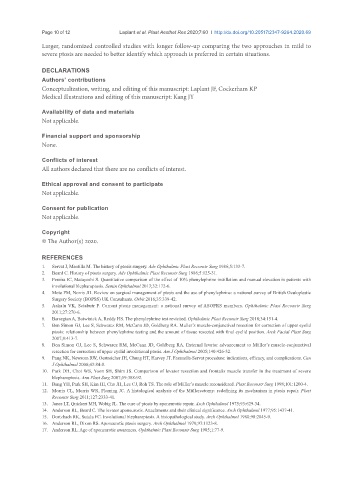Page 710 - Read Online
P. 710
Page 10 of 12 Laplant et al. Plast Aesthet Res 2020;7:60 I http://dx.doi.org/10.20517/2347-9264.2020.69
Larger, randomized controlled studies with longer follow-up comparing the two approaches in mild to
severe ptosis are needed to better identify which approach is preferred in certain situations.
DECLARATIONS
Authors’ contributions
Conceptualization, writing, and editing of this manuscript: Laplant JF, Cockerham KP
Medical illustrations and editing of this manuscript: Kang JY
Availability of data and materials
Not applicable.
Financial support and sponsorship
None.
Conflicts of interest
All authors declared that there are no conflicts of interest.
Ethical approval and consent to participate
Not applicable.
Consent for publication
Not applicable.
Copyright
© The Author(s) 2020.
REFERENCES
1. Servat J, Mantilla M. The history of ptosis surgery. Adv Ophthalmic Plast Reconstr Surg 1986;5:133-7.
2. Beard C. History of ptosis surgery. Adv Ophthalmic Plast Reconstr Surg 1986;5:125-31.
3. Pereira IC, Matayoshi S. Quantitative comparison of the effect of 10% phenylephrine instillation and manual elevation in patients with
involutional blepharoptosis. Semin Ophthalmol 2017;32:172-6.
4. Mota PM, Norris JH. Review on surgical management of ptosis and the use of phenylephrine: a national survey of British Oculoplastic
Surgery Society (BOPSS) UK Consultants. Orbit 2016;35:339-42.
5. Aakalu VK, Setabutr P. Current ptosis management: a national survey of ASOPRS members. Ophthalmic Plast Reconstr Surg
2011;27:270-6.
6. Barsegian A, Botwinick A, Reddy HS. The phenylephrine test revisited. Ophthalmic Plast Reconstr Surg 2018;34:151-4.
7. Ben Simon GJ, Lee S, Schwarcz RM, McCann JD, Goldberg RA. Muller’s muscle-conjunctival resection for correction of upper eyelid
ptosis: relationship between phenylephrine testing and the amount of tissue resected with final eyelid position. Arch Facial Plast Surg
2007;9:413-7.
8. Ben Simon GJ, Lee S, Schwarcz RM, McCann JD, Goldberg RA. External levator advancement vs Müller’s muscle-conjunctival
resection for correction of upper eyelid involutional ptosis. Am J Ophthalmol 2005;140:426-32.
9. Pang NK, Newsom RW, Oestreicher JH, Chung HT, Harvey JT. Fasanella-Servat procedure: indications, efficacy, and complications. Can
J Ophthalmol 2008;43:84-8.
10. Park DH, Choi WS, Yoon SH, Shim JS. Comparison of levator resection and frontalis muscle transfer in the treatment of severe
blepharoptosis. Ann Plast Surg 2007;59:388-92.
11. Bang YH, Park SH, Kim JH, Cho JH, Lee CJ, Roh TS. The role of Müller’s muscle reconsidered. Plast Reconstr Surg 1998;101:1200-4.
12. Morris CL, Morris WR, Fleming JC. A histological analysis of the Müllerectomy: redefining its mechanism in ptosis repair. Plast
Reconstr Surg 2011;127:2333-41.
13. Jones LT, Quickert MH, Wobig JL. The cure of ptosis by aponeurotic repair. Arch Ophthalmol 1975;93:629-34.
14. Anderson RL, Beard C. The levator aponeurosis. Attachments and their clinical significance. Arch Ophthalmol 1977;95:1437-41.
15. Dortzbach RK, Sutula FC. Involutional blepharoptosis. A histopathological study. Arch Ophthalmol 1980;98:2045-9.
16. Anderson RL, Dixon RS. Aponeurotic ptosis surgery. Arch Ophthalmol 1979;97:1123-8.
17. Anderson RL. Age of aponeurotic awareness. Ophthalmic Plast Reconstr Surg 1985;1:77-9.

